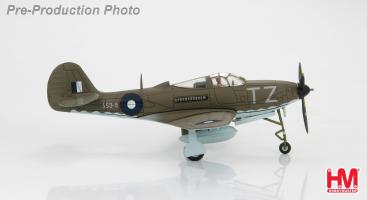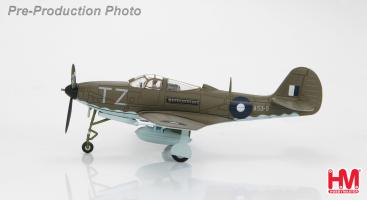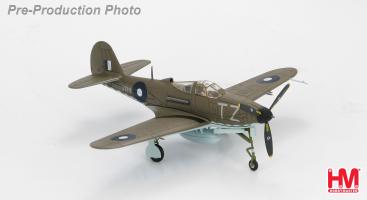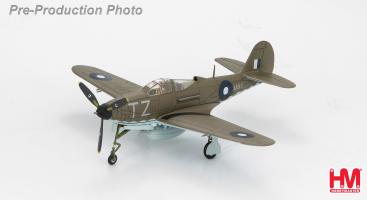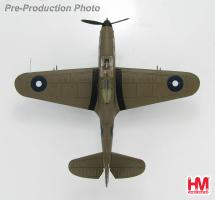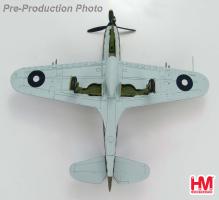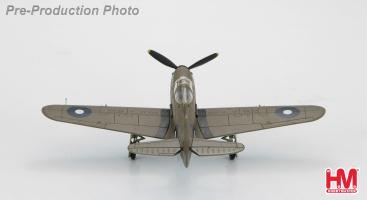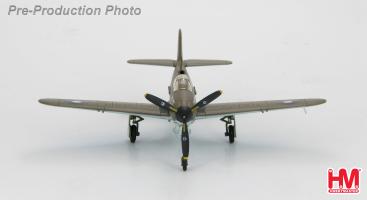Hobby Master Archive
Air Power Propellers 1/72
P-39
Bell (Model 15B) P-39F-1BE Airacobra, RAAF 24 Squadron, late 1942
Specifications for Bell P-39F First Flight - April 6, 1938 Entered Service - 1941 Improvements From Previous Variants (1) - Bullet-proof windshield and self-sealing fuel tanks were added. (2) - A 3-bladed Aeroproducts constant speed 10 ft 4 in. propeller replaced the Curtiss- Electric version because of lack of supply. (3) - Engine had 12 exhaust stubs instead of the previous 6.
Performance Engine - (1) 1150 hp Allison V-1710-35 twelve-cylinder liquid cooled engine. Maximum speed @ sea level - 309 mph @ 5,000 ft - 335 mph @ 10,000 ft - 355 mph @ 12,000 ft - 368 mph @ 15,000 ft - 360 mph Rate of Climb 1.9 minutes to 5,000 ft 5.7 minutes to 15,000 ft 9.1 minutes to 20,000 ft Service ceiling - 32,100 ft Maximum range (clean) - 600 miles @ 10,000 ft @ 231 mph.
Optional fuel - (1) 74.5 Imp gal drop tank on belly center-line Weights Empty - 5,462 lbs Gross - 7,500 lbs Maximum Take Off - 8,200 lbs Dimensions Wingspan - 34 ft Length - 30 ft 2 in Height - 11 ft 10 in Wing Area - 213 sq ft Armament (1) 37 mm cannon in nose with 30 rounds (4) wing-mounted 0.30 in. machine guns with 1000 rpg, (2) fuselage-mounted 0.50 in. machine guns with 200 rounds per gun. (1) 250 lb, 325 lb, or 500 lb bomb could be carried underneath the fuselage.
Hobby Master 1/72 Air Power Series HA1711 Bell (Model 15B) P-39F-1BE Airacobra RAAF 24 Squadron, late 1942
Die-cast metal.
Superb detailing in 1/72 scale.
Pre-painted with pad applied markings.
Fully assembled.
Accessories are not permanently attached.
Comes with a pilot figure.
Display stand included.
Option to display model with wheels up or down.
Free spinning propeller.
Minimum use of plastic.
Very collectable.
The Bell P-39 was the first American fighter to use tricycle undercarriage. Also unique was the use of a mid-mounted engine with a propeller shaft that ran from the engine through the cockpit under the pilot to the propeller. A 37mm cannon was mounted behind the gearbox and set up to fire through the propeller and the proper role the Airacobra performed marvelously and created a number of Aces.
In 1942 the RAAF found themselves with a lack of British-designed interceptors and P- 40s. Without a way to fight the Japanese bombing raids on Northern Australia towns so as a stop-gap measure the RAAF had to resort to using older P-39Ds that the USAAF 5th AF had damaged and repaired. Eventually the RAAF 24th Squadron located in Townsville received seven new P-39F-1BEs on July 27, 1942. As it turned out adequate supplies of the P-39F-1BE weren’t available either so the seven that were supplied never did see combat. By November 1943 RAAF squadrons were being supplied with adequate numbers of Vultee Vengeance aircraft so the remaining P-39s were returned to the 5th AF except for three P-39F-1BEs and one P-39D that had been written off due to accidents.
THESE ARE PRE-PRODUCTION PICTURES NOT THE FINAL VERSION
| Added to archive | 2018-03-10 |
| Last modified | 2018-03-10 |
| Leaflet | 2009-06-01 June 2009 |
